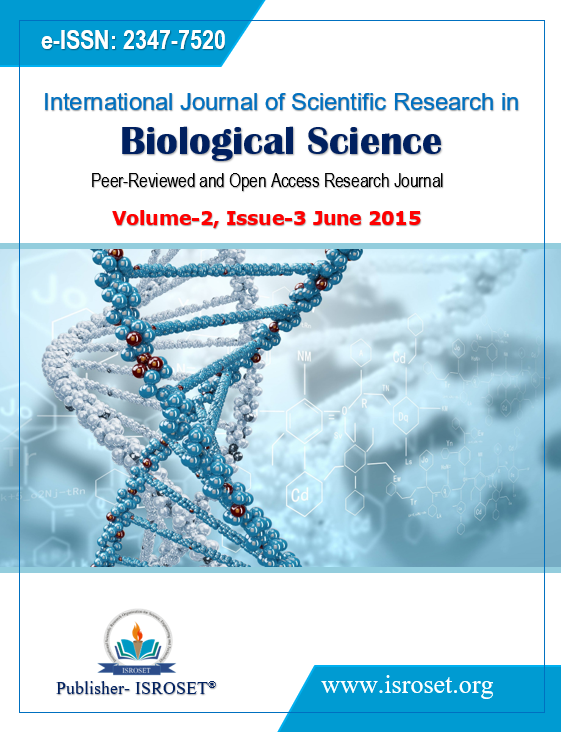Antibacterial activity of Hibiscus rosa sinensis and Calendula offcinalis flowers extract against various Pathogen
Keywords:
Hibiscus Rosa Sinensis, Calendula Offcinalis, Pseudomonas Aeruginosa, Salmonella TyphimuriumAbstract
From the long period of time, plants have been a valuable resource of natural products for human health . Some of plants leaves showing antimicrobial activity . The Primary benefit of using plant derived medicines is that they are readily affordable and accessible and showing fewer side effect . In the present study, I have evaluated that antibacterial activity of Hibiscus rosa sinensis flowers and Calendula offcinalis flowers extract against some clinical isolates of bacteria. The crude preparation of Hibiscus rosa- sinensis flowers were tested against Gram Positive- Staphylococcus aureus and Gram negative- Salmonella typhimurium, Escherichia coli, Proteus vulgaris, Pseudomonas aeruginosa. Simultaneously Standard antibiotic solution of ampicillin is used. Calendula offcinalis flowers crude extract antimicrobial activity was evaluated against Gram Positive- Staphylococcus aureus, Bacillus subtilis. Gram negative - Pseudomonas aeruginosa , E.coli , Salmonella thyphi . Gram negative bacterium - Pseudomonas aeruginosa showed maximum zone of inhibition against Hibiscus rosa- sinensis flower extract and E.coli against Calendula offcinalis among these organisms. Simultaneously standard antibiotic solution of ampicillin was used. This experiment was done by agar gel diffusion method. The flower materials can be taken as an alternative source of antibacterial agent against the human pathogens. There may be possible use of these flowers extract for making drugs. Further pharmacological and clinical studies are required. These extract may be tested against multiple drug resistance microbes.
References
Gazim ZC, Rezende CM, Fraga SR, Svidzinski TIE, Cortez DAG. Antifungal activityof the essential oil from Calendula officinalis L. (Asteraceae) growing in Brazil. Braz J Microby 2008;39:61e3.
Della LR, Tubaro A, Sosa S, Becker H, Saar S, Isaac D. The role of triperpenoids in the topical antiinflamatory activity of Calendula officinalis flowers. Planta Med 1994;60:516e20.
http://health.wikinut.com/Calendula-officinalis-Pot-Marigold/11v4g8pw/.
Mohamed RM. Dyeing of Nylon 6 fibres with Calendula officinalis & Casuarina cunninghamiana extracts. Colourage 2009;56(1):49e56.
Dweck AC. Natural ingredients for colouring and styling. Int J Cosmet Sci 2002;24(5):287e302.
Chakraborthy GS. Antimicrobial activity of the leaf extracts of Calendula officinalis (Linn.). J Herbal Med Tox 008;2(2):65e6.
Goyal M, Mathur R. Antimicrobial effects of Calendula officinalis against human pathogenic microorganisms. J Herbal Med Tox 2011; 5(1): 97e101
Chopra, R.N., Nayar, S.L. and Chopra, I.C. 1986. Glossary of Indian Medicinal Plants (Including the Supplement). Council of Scientific and Industrial Research, New Delhi.p 39.
George, M.G. 1984. Bergey’s Manual of Systematic Bacteriology, 2nd Edn. (Vol. 2),Bergey’s Manual Trust, Department of Microbiology and Molecular Genetics, Michigan State University, East Lansing, USA.
Harley, J.P. and Harley, J. 2005. Laboratory exercises in Microbiology, 6th edn.Jonadet, M., Bastide, J., Bastide, P., Boyer, B., and Carnat, A.P. 1990. In vitro enzyme inhibitory and in vivo cardioprotective activities of Hibiscus (Hibiscus sabdariffa L) J Pharm Belg. 45: 120–124.
Bauer, A.W., Kirby, W.M.M. and Sherris, J.C. 1966. Antibiotic susceptibility testing by a standardized single disk method. Am. J. Clin. Pathol., 45(4): 493-496.
Bonev B, Hooper J, Parisot J. Principles of assessing bacterial susceptibility to antibiotics using the agar diffusion method. J. Antimicro. Chemotherapy. 2008; 65(3): 01-07
Umareddy, B.2010. Enumeration of Antibacterial Activity of Few Medicinal Plants by Bioassay Method. E-Journal of Chemistry, 2010, 7(4), 1449- 1453
Ghani A. Medicinal plants of Bangladesh Chemical constituents and uses, 2nd ed., Asiatic Society of Bangladesh, Dhaka, pp 301-302-1998.
Downloads
Published
How to Cite
Issue
Section
License

This work is licensed under a Creative Commons Attribution 4.0 International License.
Authors contributing to this journal agree to publish their articles under the Creative Commons Attribution 4.0 International License, allowing third parties to share their work (copy, distribute, transmit) and to adapt it, under the condition that the authors are given credit and that in the event of reuse or distribution, the terms of this license are made clear.







